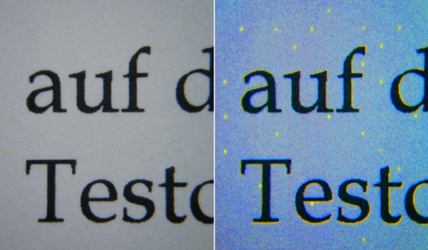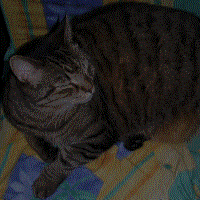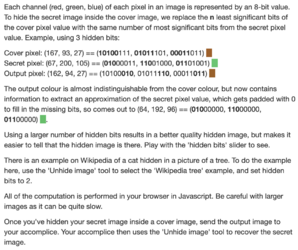- Joined
- Aug 17, 2024
Steganography is defined by Wikipedia as:
For those into computers it should be immediately evident why this would be useful to individuals concerned about privacy or those living in oppressive places, but it can also be used against you.
Perhaps one of the most common forms of steganography is done by printers in which they print a series of tiny, yellow dots on a page that represent the printer's serial number and which are invisible to the naked eye. By doing this it means any document can be traced back to a specific printer (and likely person). Here is an example of this:

A more interesting example would be hiding an image within another image. Take this image for example:

When you know how to decode that image you reveal a picture of a cat:

A good, easy to understand summary of how this is done is provided by incoherency.co.uk:

https://incoherency.co.uk/image-steganography/
At any point online you could be interacting with data that contains hidden data. You could just be unknowingly passing it along to its intended recipient, unknowingly passing it by, or someone could potentially use it against you if you were being targeted. Likewise you could be the one sending hidden data to other people to circumvent censorship, oppression, etc.
There are all kinds of steganographic methods and many are significantly more complex that the two examples I mentioned here. There's also numerous ways of attempting to prevent and defeat it, but I won't go into those right now.
Let's look at this sentence:
In this sentence I've hidden a number. Zenforo removes most invisible characters but U+180E and U+61C are not filtered so we can make use of them to hide something. I will use U+180E as 0 and U+61C as 1. The hidden data is the binary number 1000101 which is the decimal number 69 (nice).
You can see the invisible characters if you copy and paste that text into this tool: https://www.soscisurvey.de/tools/view-chars.php
Using hidden characters like these or zero width spaces is a well known way to detect when someone has copied content you own and reposted it elsewhere. This could be used for things like copyrighted articles, or pre-press releases to detect who leaked them.
Microsoft actually somewhat famously used steganography to detect Xbox 360 leaks:

I have personally implemented something like this once in a commercial product to trace back pirated versions of a piece of software to the original customer, the one who released it via torrents or warez sites.
I don't expect this to be a very active topic, but this is a subject I'm fascinated by and I imagine some of you are too.
Steganography is the practice of representing information within another message or physical object, in such a manner that the presence of the concealed information would not be evident to an unsuspecting person's examination. In computing/electronic contexts, a computer file, message, image, or video is concealed within another file, message, image, or video.
For those into computers it should be immediately evident why this would be useful to individuals concerned about privacy or those living in oppressive places, but it can also be used against you.
Perhaps one of the most common forms of steganography is done by printers in which they print a series of tiny, yellow dots on a page that represent the printer's serial number and which are invisible to the naked eye. By doing this it means any document can be traced back to a specific printer (and likely person). Here is an example of this:

A more interesting example would be hiding an image within another image. Take this image for example:

When you know how to decode that image you reveal a picture of a cat:

A good, easy to understand summary of how this is done is provided by incoherency.co.uk:

https://incoherency.co.uk/image-steganography/
At any point online you could be interacting with data that contains hidden data. You could just be unknowingly passing it along to its intended recipient, unknowingly passing it by, or someone could potentially use it against you if you were being targeted. Likewise you could be the one sending hidden data to other people to circumvent censorship, oppression, etc.
There are all kinds of steganographic methods and many are significantly more complex that the two examples I mentioned here. There's also numerous ways of attempting to prevent and defeat it, but I won't go into those right now.
Let's look at this sentence:
Yo' whatup homie I got dat riz᠋z fr nocap
In this sentence I've hidden a number. Zenforo removes most invisible characters but U+180E and U+61C are not filtered so we can make use of them to hide something. I will use U+180E as 0 and U+61C as 1. The hidden data is the binary number 1000101 which is the decimal number 69 (nice).
You can see the invisible characters if you copy and paste that text into this tool: https://www.soscisurvey.de/tools/view-chars.php
Using hidden characters like these or zero width spaces is a well known way to detect when someone has copied content you own and reposted it elsewhere. This could be used for things like copyrighted articles, or pre-press releases to detect who leaked them.
Microsoft actually somewhat famously used steganography to detect Xbox 360 leaks:

I have personally implemented something like this once in a commercial product to trace back pirated versions of a piece of software to the original customer, the one who released it via torrents or warez sites.
I don't expect this to be a very active topic, but this is a subject I'm fascinated by and I imagine some of you are too.
Last edited:


